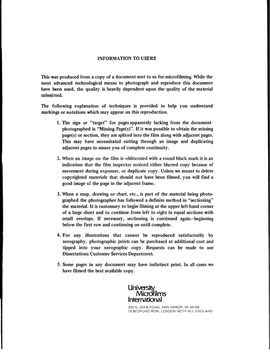| dc.contributor.author | Fixico, Donald Lee, | en_US |
| dc.date.accessioned | 2013-08-16T12:28:12Z | |
| dc.date.available | 2013-08-16T12:28:12Z | |
| dc.date.issued | 1980 | en_US |
| dc.identifier.uri | https://hdl.handle.net/11244/4767 | |
| dc.description.abstract | In contrast to the negative views of termination, the federal government and Anglo-American viewpoints have suggested that the Indian way of life was no longer viable--especially in the 20th century. Essentially termination would liberate Native Americans from their trust status as "second class" citizens to enjoy equal opportunities and privileges that other Americans were guaranteed by the Consitution. In order for Amer-indians to survive in a modernized society after World War II, Indian cultural methods of livelihood had to be altered. Emphasis on education, acculturating materialistic items of white American culture, and competing with other Americans for jobs and positions in society were viewed as Americanization of Indians. | en_US |
| dc.description.abstract | Termination has been interpreted as being good and bad for Native Americans, but in retrospect the latter has been identified more. This policy represented liquidation of reservations and dissolution of treaties. Negation of Indian rights, withdrawal of federal responsibilities to the native population and reduction of the Bureau of Indian Affairs have also been depicted as forms of termination for the purposes of mainstreaming Indians. Finally, termination has been defined as extinction of Native American cultures as the ultimate move towards transforming the Red Man into a white American. Critics argued that termination was Indian genocide. | en_US |
| dc.description.abstract | This study of federal Indian policy from World War II through the John F. Kennedy administration is concerned with the serious repercussions of this critical period of federal-Indian relations. During 1945-1963, the United States Congress initiated legislative action abrogating federal recognition of Indian groups and responsibilities to Native Americans. Concurrently Congress funded the Bureau of Indian Affairs to establish the Relocation Program, which assisted and supervised those Indians willing to remove from rural communities and reservations to metropolitan areas for economic development. | en_US |
| dc.description.abstract | Unfortunately, too often literature about American Indians has been written from the non-Indian viewpoint with disregard for the viewpoint of the people who are the subject. In studies of federal-Indian relations, the perspective of the federal government has tended to neglect the responses and views of Native Americans. To provide the best comprehensive study of federal-Indian relations during this critical period, the viewpoints of the federal government, public opinion of non-Indians, and the Indian point of view were provided to yield an overall balanced perspective. This was essential for understanding the problems of American Indians in this recent past as they prepare for the future. | en_US |
| dc.description.abstract | The zenith of termination and relocation in federal-Indian relations occurred during the 1950s. More specifically, between 1954 and 1960, over 61 tribes, groups, communities, rancherias and allotments were terminated, and relocation effected one-half of the current total Indian population living in urban areas. Certainly termination and relocation were not new concepts in federal-Indian relations, but they were interpreted ambigiously; having positive and negative effects. Termination was emphasized more in this study because of its greater degree of complexity and controversy. | en_US |
| dc.format.extent | ix, 318 leaves ; | en_US |
| dc.subject | Education, History of. | en_US |
| dc.title | Termination and relocation : | en_US |
| dc.type | Thesis | en_US |
| dc.thesis.degree | Ph.D. | en_US |
| dc.thesis.degreeDiscipline | Department of History | en_US |
| dc.note | Source: Dissertation Abstracts International, Volume: 41-06, Section: A, page: 2475. | en_US |
| ou.identifier | (UMI)AAI8027515 | en_US |
| ou.group | College of Arts and Sciences::Department of History | |
